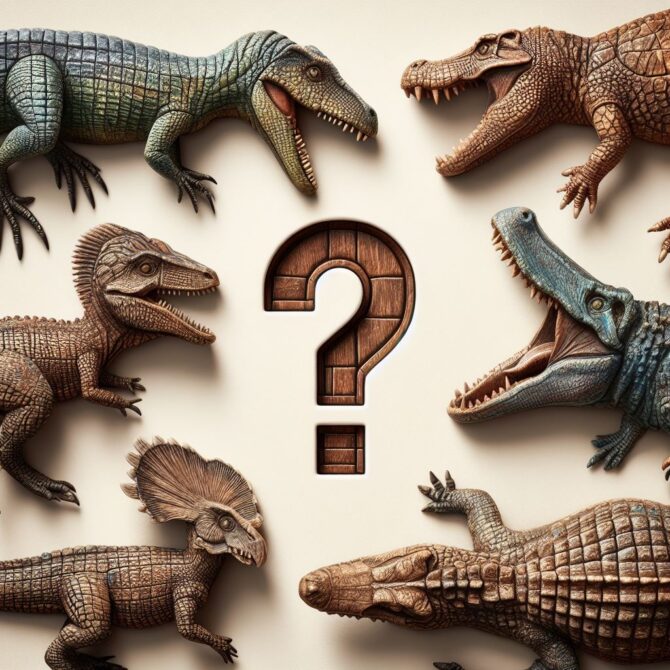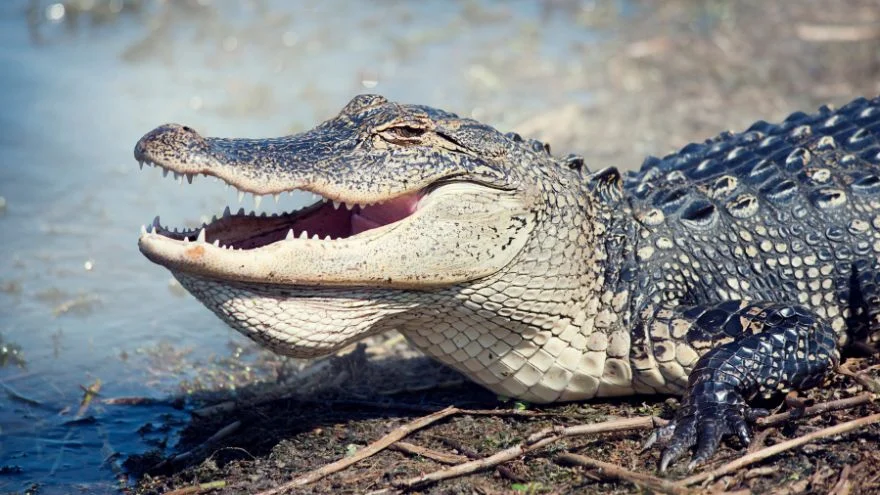The alligator is a reptile classified under the crocodilian order and the family Alligatoridae.
Due to its resemblance with the crocodile, it is sometimes mistaken as a species of the latter. However, alligators are animals of their own with two species still in existence: The American and the Chinese.
Just like their close relatives the crocodile, this reptile is large and often characterized as vicious, a reputation that didn’t come without cause.
Though not as dangerous as the croc, it still has its share of problems. This and more will be uncovered in this detailed animal profile.
Scientific Classification
- Kingdom: Animalia
- Phylum: Chordata
- Class: Reptilia
- Order: Crocodilia
- Family: Alligatoridae
- Subfamily: Alligatorinae
- Genus: Alligator
- Binomial Name: Alligator mississippiensis (American Alligator); Alligator sinensis (Chinese Alligator)
Characteristics
- Length: 5 to 15 ft
- Weight: 80 to 800 pounds
- Venom/Poison: No
- Skin Type: Scales/boney plates
- Habitat: Swamplands, marshes, rivers, streams, lakes, ponds
- Range: America, Asia
- Diet: Carnivore
- Life span: 30 to 60 years
- Gestation Period: 63 to 68 days
- Conservation status: Least Concern/Critically Endangered
5 Interesting Facts About Alligators
1. The American species is bigger than the Chinese (and less endangered)
The Chinese species is small, and more than the American. The latter weighs between 400 and 800 pounds while the former goes from 80 to 100 pounds. The American species is also longer.
Sadly, there’s a low chance of ever encountering a Chinese member to compare. This species is critically endangered with only about 100 left in the wild.
The American species was also endangered but has since increased in population.
2. These reptiles can be timid
Alligators don’t hunt after humans the way crocodiles do. The latter doesn’t need to be provoked to launch an attack, but our reptile friends are considered more peaceful and even timid as it tends to avoid humans.
However, they are not harmless. These guys can attack you if provoked, and there have been definite cases of an alligator turning on a human when it felt threatened.
3. They are ancient
Both crocodiles and alligators are ancient reptiles, not changing much even in our times. They’ve been around since the time of the dinosaurs, and they’re dated to more than 200 million years ago.
Alongside turtles and tortoises, they are some of the oldest reptiles.
The American species appeared about 84 million years ago, and there might have been a split between species that resulted in the Chinese counterpart.
4. They aren’t made for saltwater
Alligators don’t have glands that can secrete salt, which is a big difference between them and the crocodile.
Because of this, they can’t swim in saltwater and would only submerge inside freshwater. If you see a reptile of this sort stepping out of an ocean, it is a crocodile.
However, they can stay around saltwater, especially if their prey happens to be close by and the weather is suitable.
5. Gender is determined by temperature
Unlike many other animals, gender here is not determined by DNA, but by temperature. This is something found amongst reptiles more than other animal classes.
When the temperature is warm, the babies are male. However, when the temperature is cool, babies are usually female.
For temperature to work its “magic” on the eggs, the mothers lay them in dirt mounds.
General Description
As we’ve pointed out above, there are two different alligator species still alive today. They haven’t been the only species in existence, but others have since gone extinct.
We’re left with just two, and hopefully, that won’t reduce for a long time.
Altogether, these reptiles are large, the American species being more than the Chinese. Their colors include yellow, brown, and green, but then turn black in old age.
They have short legs, webs between the toes, and a large tail to propel themselves in the water. The Chinese species don’t have webbed feet, though, and its tail is wider.
The Chinese also don’t have sharp teeth, but there are many of them, similar to the American species and the Crocodile. All mentioned reptiles lose their teeth, but they replace them in no time.
Alligators come with two stomachs which all help in digestion. The first one has stones that break down the food—they don’t chew—and the second stomach does the digestion. It contains acids for that.
The word “Alligator” is believed to have come from the Spanish term el legator which means “the lizard”.
Distribution and Habitat
This animal’s range is limited, more than the crocodile and some other reptiles. You can find alligators only in the United States, China, and Mexico.
They’re spread out more in the United States, staying in states like Florida, Georgia, Alabama, Mississippi, North and South Carolina, etc. There are a few individuals in Mexico and some in China.
Habitats they inhabit include rivers, lakes, swamps, ponds, wetlands, and many others. These reptiles aren’t made for saltwater, so you’re more likely to see them around freshwater bodies.
The Chinese species are found in the Yangtze river basin, which earned them the name the Yangtze alligator.
Alligators and crocodiles aren’t usually found in the same place. The one known exception is in Southern Florida, where you can find both reptiles living close by.
Diet
The alligator is both carnivorous and opportunistic, seizing every occasion to find a meal. They find food based on their size.
Young ones can’t go after big prey, so they get their dietary needs from small animals like fish, crustaceans, insects, small mammals, and birds.
After it grows, it then starts hunting down larger animals like deer, muskrats, turtles, and coypu.
Really big individuals turn out to be apex predators in their range as they attack not just prey but also other predators.
They hunt down dogs, panthers, and even black bears. While the alligator is solitary, it can hunt in groups, possibly when going after big prey.
Humans are not prey to these animals, not like we are to crocodiles. They do not hunt down humans but will attack if threatened.
Reproduction and Mating Process
Breeding often happens during the spring, and here these solitary reptiles come together to mate. The male and female reach sexual maturity between 10 and 12 years, at which point they should have grown up to 6 feet.
The males have the task of attracting females using roars to get their attention. They also roar to ward off other males, a dominant display of sorts.
If there are other males around with intentions of finding a mate, a fight can erupt that may even get gruesome.
The whole courtship ritual is during April, and by May the mating begins. Courtship involves the male using tactile signs to begin the process. It rubs and presses the snout or body against the female.
While mating, the male mounts the female and transfers sperm into her which helps fertilize the egg. Fertilization occurs inside the female, but she lays eggs. She looks for the right spot where she builds a nest out of mud, twigs, and leaves.
It is in this nest that she lays and protects her egg. She can lay up to 50 at a time. She doesn’t directly incubate the eggs to avoid breaking them.
After 2 months, the eggs hatch. The little ones break the covering themselves. They’re usually small and vulnerable, so they remain with their mothers for about 2 years.
Predators and Threats
Baby alligators are at the most risk from predators, even after they first gain independence from their mothers. They get hunted by raccoons, bears, and bobcats. Also, bigger alligators might eat smaller ones too.
Adults are apex in their environment, and they tend to have no predators. The only threat these bigger animals face is from humans. The latter is largely responsible for the population decline of alligators.
Humans hunt these reptiles for the meat, skin, or just for the fun of it. In China, hunting these animals is illegal as they’re under numerous protection.
Behavior
Adults are solitary animals, but the smaller ones could sometimes be found in groups. This is because younger ones are not as territorial as older ones.
They are more tolerant of having other individuals around them, but the adults spend time defending their territories.
The timidity of these animals may sometimes encourage people to draw closer to them or their nest, which wounds up becoming a mistake. Attacks are rare, but not impossible.
On land, alligators have two forms of movement known as the sprawl and the high walk. With the sprawl, they move on their bellies. The high walk requires moving on all four limbs, and they use this method to travel.
The reptiles walk more than they run due to their size and slow metabolism. However, they can move fast in short intervals. It often does this while pursuing prey.
Small prey gets swallowed whole while they drag bigger ones to the water to drown them. They also perform a “death roll” when hunting.
To hunt, they use their jaw muscles to grip prey. The jaws are very strong, but the muscles are weak. This makes it possible for a person to clasp their mouth shut. Do not try this if you’re not an expert.
Male vs Female
Males and females are similar, but there are ways to tell them apart. This is especially useful for someone breeding alligators, or if you plan on taking a trip to the zoo where there might be some of these reptiles in captivity.
Size is the first difference. Females don’t grow more than 10 feet but males can get up to 15 feet. Thus, an unusually big individual is more likely to be a male.
Another trait to look out for is the presence of babies or a nest. An alligator close to a nest or with young ones will be a female.
The final difference between both sexes is the genitals. The male has a penis which becomes more obvious as they get of age. The female comes with a clitoris. A breeder can easily tell the difference by turning them around.
Frequently Asked Questions
Are alligators extinct?
These animals are still in existence, but there are only two species left. Amongst the extant species, the American alligator is the only one still secure. The Chinese variant is critically endangered, with only a few left.
What is the difference between an alligator and a crocodile?
Alligators and crocodiles are alike and belong to the same order, but they’re different animals. The crocodile is bigger with a snout that’s different from that of the alligator. The skin type differs too.
Is an alligator a good pet?
Alligators are calm reptiles and can be kept in captivity, but they are wild animals and can’t be good pets. They are also deadly, and it is illegal to own them in many states. For these reasons, you shouldn’t have one as a pet.
What animals kill alligators?
These reptiles are apex predators in the wild, so the adults face few challenges from animals. Their major threat is humans.
Conclusion
Alligators are crocodile lookalikes and could be considered a tamer version of the latter. The two extant species need all the protection they can get, and in many places, there are regulations prohibiting the hunt or capture of these animals.
These reptiles are sexual but polygamous, getting a random mate simply for mating. Their biggest threat remains humans, just as it has been for ages.

![Do Alligators Have Tongues & Taste Buds [Answered] (1)](https://animalvivid.com/wp-content/uploads/2022/09/Do-Alligators-Have-Tongues-Taste-Buds-Answered-1.jpg.webp)
![Do Alligators Shed Their Skin [Answered]](https://animalvivid.com/wp-content/uploads/2022/09/Do-Alligators-Shed-Their-Skin-Answered.jpg)
